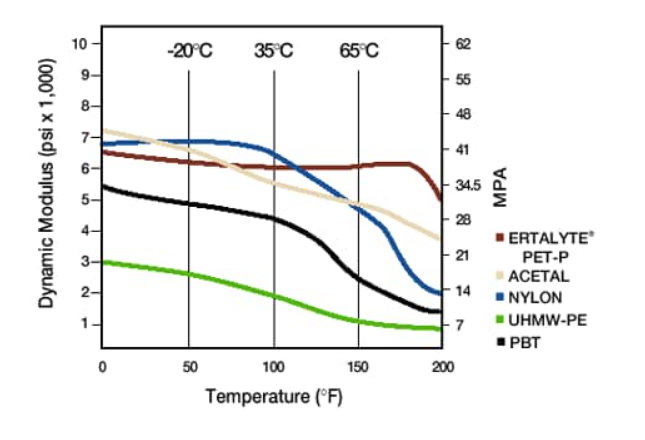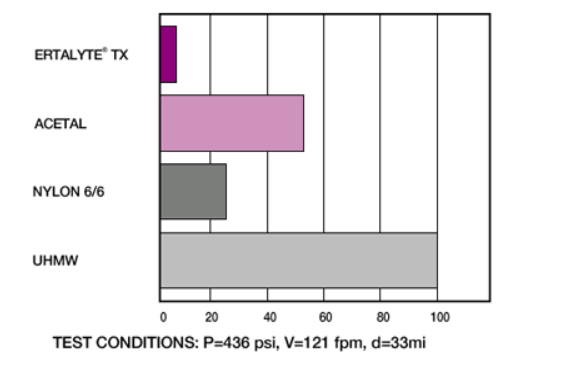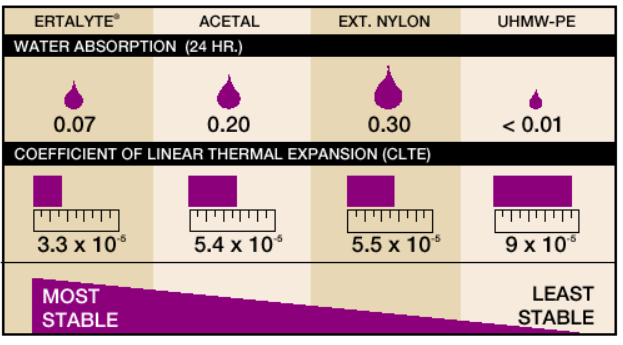Knowde Enhanced TDS
Identification & Functionality
- Chemical Family
- Polymer Name
- Technologies
- Product Families
Features & Benefits
- Labeling Claims
- Materials Features
- Product Details
Ertalyte®'s properties make it especially suitable for the manufacture of precision mechanical parts which are capable of sustaining high loads and enduring wear conditions. Ertalyte®'s continuous service temperature is 210°F (100°C) and its melting point is almost 150°F higher than acetals. It retains significantly more of its original strength up to 180°F (85°C) than nylon or acetal.
In addition, Ertalyte® PET-P offers good chemical and abrasion resistance. Its low moisture absorption enables mechanical and electrical properties to remain virtually unaffected by moisture. Ertalyte® PET-P can be machined to precise detail on standard metal working equipment.
Ertalyte® is FDA compliant in natural and black. Natural Ertalyte® is also USDA, 3A-Dairy and Canada AG compliant. Ertalyte® is an excellent candidate for parts used in the food processing and equipment industries.
- Product Overview
- Good for both wet and dry environments
- High strength and rigidity - ideal for close tolerance parts
- Excellent stain resistance
- Capable of sustaining high loads
- Good wear resistance and excellent dimensional stability
- Better resistance to acids than nylon or acetal
Applications & Uses
- Applications
- Plastics & Elastomers End Uses
- Product Applications
- Manifolds - Process and test equipment manifolds machined from Ertalyte® offer improved dimensional stability combined with superior stain and chemical resistance (Prior materials: Aluminum, Acetal).
- Food Equipment Components - Many parts on food manufacturing and processing equipment are machined from Ertalyte® - like this hamburger forming die component which meets stringent tolerance requirements and can be easily sanitized using clean-in-place chemicals (Prior material: Aluminum).
- Carousel, Filter Track, Locating Disk and Ring - Its rigidity and clean hygienic appearance - in addition to dimensional stability and resistance to dilute hydrochloric acid-made Ertalyte® the ideal choice for various components on pharmaceutical test equipment (Prior material: Nylon, UHMW-PE).
Properties
- Flame Rating
- Mechanical Properties
- Thermal Properties
- Electrical Properties
- Miscellaneous Properties
| Value | Units | Test Method / Conditions | |
| Tensile Strength | 90 | MPa | ISO 527-1/-2 (7) |
| Tensile Strain (Elongation) at Break | 15 | % | ISO 527-1/-2 (7) |
| Tensile Strain (Elongation) at Break | 4 | % | IsO 527-1/-2 (7) |
| Tensile Modulus of Elasticity | 3500 | MPa | ISO 527-1/-2 (9) |
| Shear Strength | 55 | MPa | ASTM D732 |
| Compressive Stress (1 / 2 / 5 % Nominal Strain) | 33/64/ 107 | MPa | ISO 604 (10) |
| Charpy Impact Strength (Unnotched) | 50 | kJ/m² | ISO 179-1/1eU |
| Charpy Impact Strength (Notched) | 2 | kJ/m² | ISO 179-1/1eA |
| Flexural Strength | 135 | MPa | ISO 178 (12) |
| Flexural Modulus of Elasticity | 3300 | MPa | ISO 178 (12) |
| Hardness (14) | 96 | Rockwell M | ISO 2039-2 |
| Hardness (14) | 80 | Shore D | ISO 2039-2 |
| Value | Units | Test Method / Conditions | |
| Melting Temperature (DSC, 10°C (50°F) / min) | 245 | °C | ISO 11357-1/-3 |
| Thermal Conductivity (23°C) | 0.29 | W/(K.m) | — |
| Coefficient of Linear Thermal Expansion (23 - 60°C) | 60 | µm/(m.K) | — |
| Coefficient of Linear Thermal Expansion (23 - 100°C) | 80 | µm/(m.K) | — |
| Heat Deflection Temperature (Method A: 1.8 MPa (264 PSI)) | 80 | °C | ISO 75-1/-2 |
| Continuous Allowable Service Temperature in Air (20.000 hrs) (3) | 100 | °C | — |
| Minimum Service Temperature (4) | -20 | °C | — |
| Flammability (3 mm) (5) | HB | — | UL 94 |
| Flammability (Oxygen Index) | 25 | % | ISO 4589-1/-2 |
| Value | Units | Test Method / Conditions | |
| Electric Strength | 22 | kV/mm | IEC 60243-1 (15) |
| Volume Resistivity | 100000000000000 | Ohm.cm | IEC 62631-3-1 |
| Surface Resistivity | 10000000000000 | Ohm/sq. | ANSI/ESD STM 11.11 |
| Dielectric Constant (1 MHz) | 3.2 | — | IEC 62631-2-1 |
| Dissipation Factor (1 MHz) | 0.014 | — | IEC 62631-2-1 |
| Value | Units | Test Method / Conditions | |
| Density | 1.39 | g/cm³ | ISO 1183-1 |
| Water Absorption (After 24h Immersion in Water of 23°C) | 0.07 | % | ISO 62 (16) |
| Water Absorption (At Saturation in Water of 23 °C) | 0.5 | % | — |
| Wear Rate | 3 | µm/km | ISO 7148-2 (18) |
| Dynamic Coefficient of Friction | 0.15 - 0.25 | — | ISO 7148-2 (18) |
| Limiting PV (0.1/1 m/s Cylindrical Sleeve Bearings) | 0.15/0.09 | Mpa.m/s | — |
Regulatory & Compliance
- Certifications & Compliance
- Chemical Inventories
Technical Details & Test Data
- Ertalyte Offers Better Strength in Higher Temperatures

- Wear Rate (k-Factor)

- Stability of Engineering Materials

- Note
- Thermal Properties - The figures given for these properties are for the most part derived from raw material supplier data and other publications.
- (2) Values for this property are only given here for amorphous materials and for materials that do not show a melting temperature (PBI, PAI & PI). DMA settings, oscillation amplitude of 0.20 mm; a frequency of 1 Hz; heating rate of 2°C/min
- (3) Temperature resistance over a period of min. 20,000 hours. After this period of time, there is a decrease in tensile strength – measured at 23 °C – of about 50 % as compared with the original value. The temperature value given here is thus based on the thermal-oxidative degradation which takes place and causes a reduction in properties. Note, however, that the maximum allowable service temperature depends in many cases essentially on the duration and the magnitude of the mechanical stresses to which the material is subjected.
- (4) Impact strength decreasing with decreasing temperature, the minimum allowable service temperature is practically mainly determined by the extent to which the material is subjected to impact. The value given here is based on unfavorable impact conditions and may consequently not be considered as being the absolute practical limit.
- (5) These estimated ratings, derived from raw material supplier data and other publications, are not intended to reflect hazards presented by the material under actual fire conditions. There is no ‘UL File Number’ available for these stock shapes.
- Mechanical Properties - Most of the figures given for the mechanical properties are average values of tests run on dry test specimens machined out of rods 40-60 mm when available, else out of plate 10-20mm. All tests are done at room temperature (23° / 73°F)
- (7) Test speed: either 5 mm/min or 50 mm/min [chosen acc. to ISO 10350-1 as a function of the ductile behavior of the material (tough or brittle)] using type 1B tensile bars
- (8) Test speed: either 0.2"/min or 2"/min or [chosen as a function of the ductile behavior of the material (brittle or tough)] using Type 1 tensile bars
- (9) Test speed: 1 mm/min, using type 1B tensile bars
- (10) Test specimens: cylinders Ø 8 mm x 16 mm, test speed 1 mm/min
- (11) Test specimens: cylinders Ø 0.5" x 1", or square 0.5" x 1", test speed 0.05"/min
- (12) Test specimens: bars 4 mm (thickness) x 10 mm x 80 mm; test speed: 2 mm/min; span: 64 mm.
- (13) Test specimens: bars 0.25" (thickness) x 0.5" x 5"; test speed: 0.11"/min; span: 4"
- (14) Measured on 10 mm, 0.4" thick test specimens.
- (15) Electrode configuration: Ø 25 / Ø 75 mm coaxial cylinders; in transformer oil according to IEC 60296 ; 1 mm thick test specimens.
- (16) Measured on disks Ø 50 mm x 3 mm.
- (17) Measured on 1/8" thick x 2" diameter or square
- (18) Test procedure similar to Test Method A: “Pin-on-disk” as described in ISO 7148-2, Load 3MPa, sliding velocity= 0,33 m/s, mating plate steel Ra= 0.7-0.9 μm, tested at 23°C, 50%RH.
- (19) Test using journal bearing system, 200 hrs, 118 ft/min, 42 PSI, steel shaft roughness 16±2 RMS micro inches with Hardness Brinell of 180-200
- (20) Test using Plastic Thrust Washer rotating against steel, 20 ft/min and 250 PSI, Stationary steel washer roughness 16±2 RMS micro inches with Rockwell C 20-24
- (21) Test using Plastic Thrust Washer rotating against steel, Step by step increase pressure, Test ends when plastic begins to deform or if temperature increases to 300°F.
- Engineering Notes
Because it is more rigid and offers greater thermal performance than nylon and acetal, Ertalyte machines differently. For best results, please request a copy of Mitsubishi Chemical Advanced Materials's design and fabrication guideline for Ertalyte® PET-P. Ertalyte® and other polyesters have less resistance to hot water than Acetron® GP acetal.

